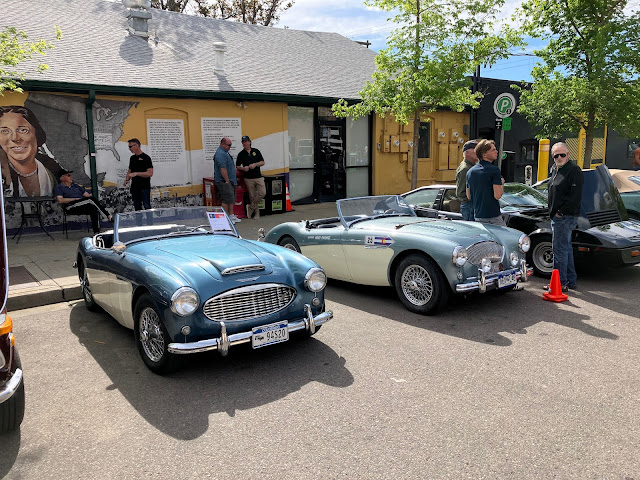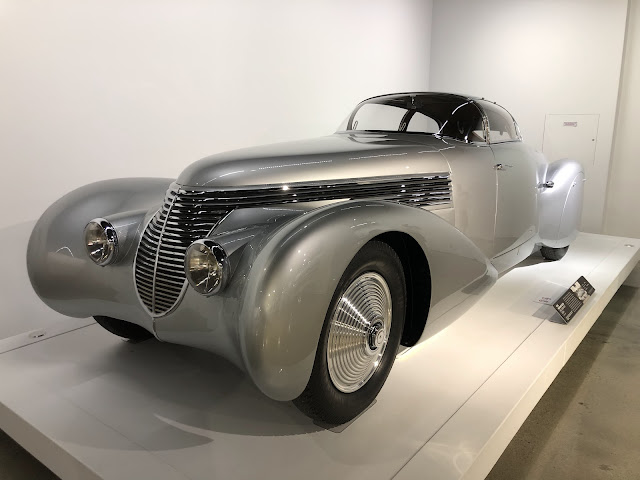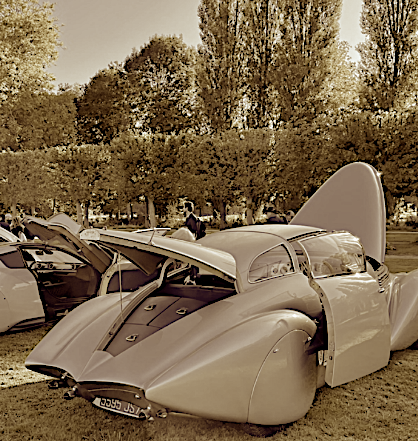Pinin Farina's body for the Cisitalia 202 Gran Sport was enough of a stunner in 1947 that it got the obscure, Fiat-powered coupe onto the list of contenders for the first breakthrough car design after World War II. Walking around the car gives some clues about why...
This light alloy shell, credited to designer Giovanni Savonuzzi and mounted on a multi-tubular chassis powered by a 1.1 liter Fiat engine, introduced several themes that would be repeated on other postwar cars. Note the way the front fenders peak well above the gently sloping hood line, and the way the slab-sided look of other early postwar designs has been avoided by continuing the front fender curve down and past the window sill, until it meets the subtle, separate curve of the rear fender. The inward curve at the base of fenders and sill sections avoids the flat, static look of slab-sided cars. Also, the general lack of decoration is striking.
In the context of that lack, the overall handling of form becomes more important, and details like the headlight trims, hubcaps and delicate, curved grille bars stand out. The way the contours of the rear fenders blend seamlessly into the sloping roof form was new in 1947, and distinct from most prewar designs, with their separate fenders riding outboard of narrower passenger cabins, often with running boards. The phrase "GT car" was not in common use in 1947, but the Cisitalia 202 Gran Sport served as a template for the forms of many GT cars that came after it.
Many of those cars, including offerings from Lancia and Aston Martin, would in the next decade offer around twice the power of the Cisitalia in the same price class; the U.S. sticker on a 202 Gran Sport was $6,800, but the 67 cubic inch Fiat engine with Cisitalia head made only 60 hp. This was enough to make Cisitalia competitive in small-bore road racing, especially their lightweight racers, but it was the Gran Sport design that got the attention of wealthy enthusiasts, and landed it in the 1951 exhibit, 8 Automobiles, organized by Museum of Modern Art curator Arthur Drexler.
A decade later, well-heeled US road racers in the SCCA started salivating when Jaguar announced their intention to offer a series-production version of their Le Mans-winning D-Type endurance racer to customers. The promise was that the new car would be a true dual-purpose sports car, offering enough comfort, weather protection and convenience to be practical as transport, while offering something like the D-Type's performance to weekend racers. In reality, the plan was to start by converting 25 unsold D-Type chassis to the road-going specifications.
The new car shared the D-Type's stressed-skin central chassis tub, comprising the cockpit, front and rear bulkheads in elliptical section, and side bulkheads, largely formed in sheet aluminum. As on the D-Type, a tubular subframe attached to the front bulkhead and this carried the dry-sump XK engine and front suspension, along with rack and pinion steering. D-Type body designer Malcolm Sayer prioritized low frontal area along with strength and light weight, and his concerns with aerodynamics were reflected in the repeated elliptical shapes of the riveted aluminum shell, an almost musical composition of ovals in section, plan and elevation...
Practical concerns didn't have so much sway. The tiny door openings resulting from the deep structural sills made access awkward, especially with the top erected. Side windows wouldn't open, but could be removed. The bumpers functioned more as bright trim than as body protection. So the XK-SS, as it was named, placed emphasis more on effectiveness as a weekend racer than practicality for commuting or even weekend touring. As a piece of rolling sculpture, though, it was hard to ignore...
And the promised performance was really there. Tested in 1957 by Road & Track, the 2,230 pound, 250 hp car recorded a 5.2 second 0-60 time and hit 100 in 13.6 seconds, with the best quarter mile run in 13.9. As with the D-Type, 4-wheel disc brakes provided ample stopping power, and the stated list price of $5,600 seemed a bargain. But a disastrous fire at Jaguar's Coventry factory in February 1957 destroyed 9 of the chassis, putting the whole program in doubt.
That fire has been blamed for the early demise of the XK-SS, but there may have been other factors. The riveted aluminum body construction was unsuited to mass production, and the tiny doors, cramped cockpit and sketchy weather protection were not in line with the practical virtues of the then-new XK-150, also introduced in 1957. As a result, only 16 specimens of the XK-SS found customers. And though it was extremely rare and a design landmark, the XK-SS, unlike the Cisitalia 202 Gran Sport, never made it into the Museum of Modern Art's permanent collection. That honor would be reserved for the E-Type that went into large-scale production four years after the XK-SS project was cut short.
*Footnote: This blog surveyed the history of the Cisitalia marque in "The Etceterini Files, Part Eleven---Cisitalia: Fiats as Fine Art", posted April 22, 2017, and traced the design origins of the D-Type Jaguar, the road racer that provided the basis of Jaguar's XK-SS, in "Shipshape, From an Aircraft Point of View: Jaguar D-Type", posted on July 28, 2017.
Photo Credits
Top and 2nd from bottom: Gogo Heinrich
All other photos: Art Heinrich
All photos were taken at the Petersen Automotive Museum at 6060 Wilshire Boulevard in Los Angeles, CA 90036. Their information line is 323-930-2277.











































